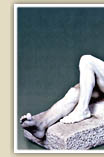
But as artists became familiar with the work of Rodin
and, from the First World War onwards, with European developments generally,
Greek sculpture was led to explore a more modern approach. The whole period can be considered as a link between
Academicism and Modernism, which emerged after 1922.
Sculpture was expected to express the patriotic element and immortalize
the national triumphs of the time. Reputable sculptors of the era included Lazaros Sochos, Georgios Bonanos, Georgios Vroutos and Dimitrios
Philippotis. Sculptural compositions such as the Grave Monument of Nikolaso Stergiou Family
in the First Cemetery (1917) or the Grave Monument of Athinogenis Family in the First Cemetery (1910) by
Petros Roubos, both art deco in style, demonstrate the tendency of Greek sculpture
towards more modern forms. On the other hand, Thomas Thomopoulos's (Aftothisia, (Self-Sacrifice) of 1902, Kostas Dimitriadis's (Andras (Man) of 1910, and Choreftria (Dancer) of 1920 clearly express this transition period, the former being more Classical,
|
 |

influenced by Rodin whrereas the latter shows the influence of Bourdelle. Generally, one can note in this period the disengagement
of Greek sculpture from the Classical tradition and the admittance of the teachings of European modernists. Georgios Dimitriadis, a prolific Athenian sculptor, remained faithful to the Academic tradition.
Towards the end of the period began the second phase Yannoulis Chalepas's career, after a long period of silence caused by his mental breakdown. From
1918 onwards the new period begins in sharp contrast to the previous one,
known as his 'post-reasonable' period. Thanks to the works of this period
Chalepas is placed among the most important European artists.
|
 |
